

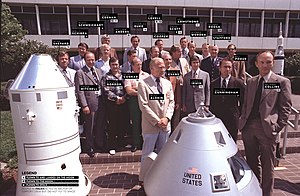
As part of the Apollo programbyNASA, 24 astronauts flew nine missions to the Moon between December 1968 and December 1972. During six successful two-man landing missions, twelve men walked on the lunar surface, six of whom drove Lunar Roving Vehicles as part of the last three missions. Three men have been to the Moon twice, one orbited once and took a circumlunar trajectory the second time, while the other two landed once apiece. Apart from these 24 men, no human being has gone beyond low Earth orbit. As of June 2024[update], 6 of the 24 remain alive. No woman has been to the Moon, but a number of non-human animals have circled or orbited it, including two tortoises, several turtles, and five mice.
Apollo missions 8 and 10–17 were the nine crewed missions to the Moon. Apollo 4–6 and AS-201 and AS-202 were uncrewed, while AS-203 is considered a test flight. The Apollo program included three other crewed missions: Apollo 1 (AS-204) did not launch and its crew died in a ground-based capsule fire, while Apollo 7 and Apollo 9 were low Earth orbit missions that only tested spacecraft components and docking maneuvers. Apollo missions 18, 19, and 20 were canceled. Twelve astronauts later flew unused Apollo command modules in the Apollo Applications Program's Skylab and Apollo–Soyuz Test Project. Of the 24 astronauts who flew to the Moon, two went on to command a Skylab mission, one commanded Apollo–Soyuz, one flew as commander for Approach and Landing Tests of the Space Shuttle, and two commanded orbital Space Shuttle missions.
NASA's Director of Flight Crew Operations during the Gemini and Apollo programs was Donald K. "Deke" Slayton, one of the original Mercury Seven astronauts, who was medically grounded in September 1962 due to a minor cardiac arrhythmia – paroxysmal atrial fibrillation. Slayton was responsible for making all Gemini and Apollo crew assignments. In March 1972, Slayton was restored to flight status, and flew on the 1975 Apollo–Soyuz Test Project mission.
The prime crew members selected for actual missions are here grouped by their NASA astronaut selection groups, and within each group in the order selected for flight. Two versions of the Apollo Command/Service Module (CSM) spacecraft were developed: Block I, intended for preliminary low Earth orbit testing; and Block II, redesigned for the lunar landing. The Block I crew position titles were Command Pilot, Senior Pilot (second seat), and Pilot (third seat). The corresponding Block II titles were: Commander, Command Module Pilot, and Lunar Module Pilot. The second seat pilot was given secondary responsibility for celestial navigation to keep the CSM's guidance computer accurately calibrated with the spacecraft's true position, and the third seat pilot served as a flight engineer, monitoring the health of the spacecraft systems.

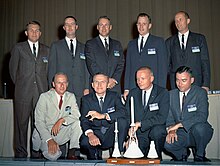
All of these astronauts flew on Gemini, and except for White, each commanded one Gemini and one Apollo mission:
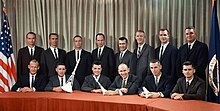
This was the first class of astronauts for which test pilot experience was not required, but military jet fighter pilot experience was acceptable.
Five of this group got their first spaceflight experience as second seat on Gemini:
The remaining six members of this group were selected for their first space flights on Apollo:

In June 1965, NASA named a group of five scientist astronauts, the first group qualified by doctorate degrees rather than test or military fighter pilot experience.[nb 1] Geologist Harrison H. "Jack" Schmitt participated heavily in the geological training of the lunar landing astronauts, as well as assisting in the analysis of returned samples and the preparation of mission reports. In 1970, he was selected as Lunar Module Pilot for the Apollo 15 backup crew, and prime crew on Apollo 18. When program cutbacks canceled missions 18 through 20, NASA's lunar geological community insisted on having a geologist on the Moon, so Slayton reassigned Schmitt to Apollo 17.

NASA named a group of 19 more astronauts in April 1966. None had spaceflight experience before their Apollo mission.
Twelve men walked on the Moon during six Moon landings of the Apollo program between July 1969 and December 1972. All landed on the surface only once, and five missions consisted of two or more surface extravehicular activities (EVAs). Four of them are alive as of June 2024[update] with an average age of 91 years. Most astronauts at that time came from the military services and were considered to be on active duty during their NASA service. The few exceptions were considered civilian NASA astronauts, regardless of any prior military service.
On the last of their three Apollo 17 EVAs, Harrison Schmitt stepped out of the Apollo Lunar Module onto the surface of the Moon after Gene Cernan, and is therefore the 12th and most recent person to have stepped out onto the Moon. When they re-entered the lunar module Cernan stepped in last, and is therefore the last person to have walked on the Moon.
Alan Shepard was the oldest person to walk on the Moon, at age 47 years and 80 days. Charles Duke was the youngest, at age 36 years and 201 days.
Jim Lovell and Fred Haise were scheduled to walk on the Moon during the Apollo 13 mission, but the lunar landing was aborted following an explosion in the spacecraft service module en route to the Moon. Haise was again scheduled to walk on the Moon as commander of Apollo 19, but Apollo 18 and Apollo 19 were canceled on September 2, 1970.
Joe Engle had trained on the backup crew for Apollo 14 to explore the Moon with Cernan, but he was replaced by Schmitt on the primary crew for Apollo 17. Schmitt had previously been crewed with Apollo 12 Command Module pilot Dick Gordon in anticipation of Apollo 18, but Schmitt replaced Engle on Apollo 17 after the cancellation of Apollo 18 and Apollo 19, leaving Gordon as the last Apollo astronaut to train extensively for lunar exploration without ever landing on the Moon.
| Portrait | Name and group | Born | Died | Age at first step |
Mission | Lunar Module Landing Time (UTC)[5] | Lunar Module Ascent Time (UTC)[5] | Elapsed Time on Lunar Surface | Lunar EVAs[5] | Total EVA Duration[5] | Military service | Alma mater | |
|---|---|---|---|---|---|---|---|---|---|---|---|---|---|
| 1 |  |
Neil Armstrong (NASA Astronaut Group 2) |
(1930-08-05)August 5, 1930 | August 25, 2012(2012-08-25) (aged 82) | 38y 11m 15d | Apollo 11 | July 20, 1969 at 8:17 PM | July 21, 1969 at 5:54 PM | 21 hours 37 minutes | 1 | 2 hours 31 minutes | Civilian[nb 2] (Navy veteran) | Purdue University, University of Southern California |
| 2 | 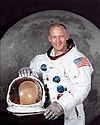 |
Buzz Aldrin (NASA Astronaut Group 3) |
(1930-01-20) January 20, 1930 (age 94) | 39y 6m 0d | 1 | 2 hours 31 minutes | Air Force | United States Military Academy, MIT | |||||
| 3 |  |
Pete Conrad (NASA Astronaut Group 2) |
(1930-06-02)June 2, 1930 | July 8, 1999(1999-07-08) (aged 69) | 39y 5m 17d | Apollo 12 | November 19, 1969 at 6:54 AM | November 20, 1969 at 2:25 PM | 1 day 7 hours 31 minutes | 2 | 7 hours 45 minutes | Navy | Princeton University |
| 4 | 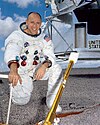 |
Alan Bean (NASA Astronaut Group 3) |
(1932-03-15)March 15, 1932 | May 26, 2018(2018-05-26) (aged 86) | 37y 8m 4d | 2 | 7 hours 45 minutes | Navy | University of Texas, Austin | ||||
| 5 |  |
Alan Shepard (Mercury Seven) |
(1923-11-18)November 18, 1923 | July 21, 1998(1998-07-21) (aged 74) | 47y 2m 18d | Apollo 14 | February 5, 1971 at 9:18 AM | February 6, 1971 at 6:48 PM | 1 day 9 hours 30 minutes | 2 | 9 hours 22 minutes | Navy | United States Naval Academy, Naval War College |
| 6 |  |
Edgar Mitchell (NASA Astronaut Group 5) |
(1930-09-17)September 17, 1930 | February 4, 2016(2016-02-04) (aged 85) | 40y 4m 19d | 2 | 9 hours 22 minutes | Navy | Carnegie Mellon University, Naval Postgraduate School, MIT | ||||
| 7 |  |
David Scott (NASA Astronaut Group 3) |
(1932-06-06) June 6, 1932 (age 92) | 39y 1m 25d | Apollo 15 | July 30, 1971 at 10:16 PM | August 2, 1971 at 5:11 PM | 2 days 18 hours 55 minutes | 3 | 18 hours 34 minutes | Air Force | University of Michigan, United States Military Academy, MIT | |
| 8 |  |
James Irwin (NASA Astronaut Group 5) |
(1930-03-17)March 17, 1930 | August 8, 1991(1991-08-08) (aged 61) | 41y 4m 14d | 3 | 18 hours 34 minutes | Air Force | United States Naval Academy, University of Michigan | ||||
| 9 |  |
John Young (NASA Astronaut Group 2) |
(1930-09-24)September 24, 1930 | January 5, 2018(2018-01-05) (aged 87) | 41y 6m 28d | Apollo 16 | April 21, 1972 at 2:23 AM | April 24, 1972 at 1:25 AM | 2 days 23 hours 2 minutes | 3 | 20 hours 14 minutes | Navy | Georgia Institute of Technology |
| 10 |  |
Charles Duke (NASA Astronaut Group 5) |
(1935-10-03) October 3, 1935 (age 88) | 36y 6m 18d | 3 | 20 hours 14 minutes | Air Force | United States Naval Academy, MIT | |||||
| 11 |  |
Eugene Cernan (NASA Astronaut Group 3) |
(1934-03-14)March 14, 1934 | January 16, 2017(2017-01-16) (aged 82) | 38y 9m 7d | Apollo 17 | December 11, 1972 at 7:54 PM | December 14, 1972 at 10:54 PM | 3 days 3 hours 0 minutes | 3 | 22 hours 3 minutes | Navy | Purdue University, Naval Postgraduate School |
| 12 |  |
Harrison Schmitt (NASA Astronaut Group 4) |
(1935-07-03) July 3, 1935 (age 88) | 37y 5m 8d | 3 | 22 hours 3 minutes | Civilian[nb 3] | Caltech, University of Oslo, Harvard University |
Besides the 12 people who have walked on the Moon, 12 more have flown to within 0.001 lunar distance of its surface. As of June 2024[update], two of them are alive with an average age of 93 years. During each of the six missions with successful lunar landings, one astronaut remained in lunar orbit while the other two landed. In addition, the three-person crews of Apollo 8 and Apollo 10 also entered lunar orbit, and the crew of Apollo 13 looped around the Moon on a free-return trajectory.
All nine crewed missions to the Moon took place as part of the Apollo program over a period of just under four years, from 21 December 1968 to 19 December 1972. The 24 people who have flown to the Moon are the only people who have traveled beyond low Earth orbit.
Jim Lovell, John Young, and Eugene Cernan are the only three people to have flown to the Moon twice. Young and Cernan each set foot on it during their respective second lunar missions, while Lovell is the only person to have flown to the Moon twice without landing.
During Cernan's first lunar mission on Apollo 10, he tied the present record set by Bill Anders on Apollo 8 as the youngest person to fly to the Moon. Each was 35 years and 65 days old on his launch date and 35 years and 68 days old when he entered lunar orbit. The oldest person to fly to the Moon was Alan Shepard, who walked on its surface during the Apollo 14 mission. Shepard was 47 years and 74 days old on his launch date and 47 years and 78 days old when he entered lunar orbit.
Jim Lovell and Fred Haise were scheduled to walk on the Moon during the Apollo 13 mission, but the lunar landing was aborted following a major malfunction en route to the Moon.[6] Haise was again scheduled to walk on the Moon as commander of Apollo 19, but Apollo 18 and Apollo 19 were canceled on September 2, 1970. Because of Apollo 13's free-return trajectory, Lovell, Swigert and Haise flew higher above the Moon's 180° meridian (opposite Earth) than anyone else has flown (254 km/158 mi). Coincidentally, due to the Moon's distance from Earth at the time, they simultaneously set the present record for humans' greatest distance from Earth, reaching an altitude of 400,171 km (248,655 mi) above sea level at 0:21 UTC on 15 April 1970.
| Portrait | Name and group | Born | Died | Age | Mission | Military service | Notes | |
|---|---|---|---|---|---|---|---|---|
| 1 | 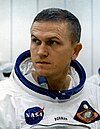 |
Frank Borman (NASA Astronaut Group 2) |
(1928-03-14)March 14, 1928 | November 7, 2023(2023-11-07) (aged 95) | 40 | Apollo 8 December 21–27, 1968 |
Air Force | |
| 2 |  |
Jim Lovell (NASA Astronaut Group 2) |
(1928-03-25) March 25, 1928 (age 96) | 40 42 |
Apollo 8 December 21–27, 1968 Apollo 13 April 11–17, 1970 |
Navy | Intended to land on Apollo 13; only person to fly to the Moon twice without landing. | |
| 3 | 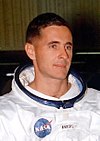 |
Bill Anders (NASA Astronaut Group 3) |
(1933-10-17)October 17, 1933 | June 7, 2024
(aged 90) |
35 | Apollo 8 December 21–27, 1968 |
Air Force | |
| 4 | 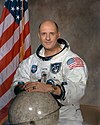 |
Tom Stafford (NASA Astronaut Group 2) |
(1930-09-17)September 17, 1930 | March 18, 2024(2024-03-18) (aged 93) | 38 | Apollo 10 May 18–26, 1969 |
Air Force | Later flew on Apollo–Soyuz Test Project. |
| 5 |  |
Michael Collins (NASA Astronaut Group 3) |
(1930-10-31)October 31, 1930 | April 28, 2021(2021-04-28) (aged 90) | 38 | Apollo 11 July 16–24, 1969 |
Air Force | |
| 6 | 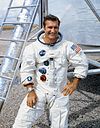 |
Dick Gordon (NASA Astronaut Group 3) |
(1929-10-05)October 5, 1929 | November 6, 2017(2017-11-06) (aged 88) | 40 | Apollo 12 November 14–24, 1969 |
Navy | Trained to land, slated for Apollo 18 (canceled).[7] |
| 7 | 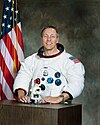 |
Jack Swigert (NASA Astronaut Group 5) |
(1931-08-30)August 30, 1931 | December 27, 1982(1982-12-27) (aged 51) | 38 | Apollo 13 April 11–17, 1970 |
Air Force | |
| 8 |  |
Fred Haise (NASA Astronaut Group 5) |
(1933-11-14) November 14, 1933 (age 90) | 36 | Apollo 13 April 11–17, 1970 |
Marines, Air Force | Intended to land; later trained to land and slated to command Apollo 19 (canceled);[7] flew the Space Shuttle on approach / landing tests. | |
| 9 | 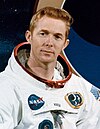 |
Stuart Roosa (NASA Astronaut Group 5) |
(1933-08-16)August 16, 1933 | December 12, 1994(1994-12-12) (aged 61) | 37 | Apollo 14 January 31 – February 9, 1971 |
Air Force | In rotation to land on Apollo 20 (canceled). |
| 10 |  |
Al Worden (NASA Astronaut Group 5) |
(1932-02-07)February 7, 1932 | March 18, 2020(2020-03-18) (aged 88) | 39 | Apollo 15 July 26 – August 7, 1971 |
Air Force | |
| 11 | 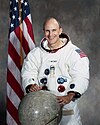 |
Ken Mattingly (NASA Astronaut Group 5) |
(1936-03-17)March 17, 1936 | October 31, 2023(2023-10-31) (aged 87) | 36 | Apollo 16 April 16–27, 1972 |
Navy | Later flew two Space Shuttle missions. |
| 12 | 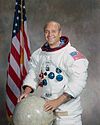 |
Ron Evans (NASA Astronaut Group 5) |
(1933-11-10)November 10, 1933 | April 7, 1990(1990-04-07) (aged 56) | 39 | Apollo 17 December 7–19, 1972 |
Navy |
Armstrong descended the lunar module ladder and spoke his famous epigram, "That's one small step for [a] man, one giant leap for mankind."[8] He then went to work on collecting the contingency sample, which was a scoop of the lunar surface collected early in the mission in case there was an emergency.[9] Armstrong took the TV camera off the lunar module and mounted it to a tripod.[10] After that, Aldrin descended the ladder to join Armstrong.[11] Aldrin egressed to the surface about nineteen minutes after Armstrong.[12] They had some trouble planting the American flag into the lunar soil, but were able to secure it into the surface. Aldrin positioned himself in front of a video camera and began experimenting with different locomotion techniques on the surface.[13] During these experiments, Armstrong and Aldrin received a phone call from President Nixon, congratulating them for the successful landing.[14]
Aldrin then set to work documenting the condition of the spacecraft to ensure it was in proper condition for their upcoming launch. After setting up a couple of experiments with Armstrong, Aldrin went to work hammering a tube into the lunar surface to obtain a core sample.[15] Aldrin's EVA ended when they loaded the lunar samples into the spacecraft and tossed out unneeded items, just before sealing the hatch.[10] Armstrong performed the majority of the photography on the surface, which is why there are only five photos of him on the Moon.[16]
Soon after piloting the LM Falcon to a landing at Hadley Rille, Scott accomplished the only stand-up EVA through the lander's top hatch, using it as a high place from which to refine the geology traverses he and Irwin would undertake during the following days. Scott became the first to drive a vehicle on the Moon as he drove the Lunar Roving Vehicle, more than doubling Apollo 14's EVA time. After the final traverse, back outside the LM, Scott performed a demonstration of Galileo's theory that all objects fall at the same rate in vacuum by dropping a hammer and a feather for the television camera.
Irwin came onto the lunar surface soon after his commander, Scott. As the LRV's first passenger, he had an often rough ride as Scott swerved to avoid craters.[17] It was Irwin who, during the second EVA, first spotted the Genesis Rock and aided Scott in collecting this bit of the early lunar crust.[18] A man of deep Christian religious faith, Irwin quoted from Psalms while on the lunar surface and later became an evangelist.[19]
In addition to the nine lunar missions, there were two crewed flights in the Apollo program that remained in Earth orbit to test fly the spacecraft. Apollo 7 was a crewed test flight of the CSM, and Apollo 9 was a crewed flight test of the CSM and LEM. Of the six astronauts who participated in these missions, five were never rotated to a lunar mission. In addition, the three Skylab missions and Apollo-Soyuz Test Project used crewed CSMs in Earth orbit and are considered part of the Apollo Applications Project. Although Conrad, Bean, and Stafford commanded three of these four flights, the remaining crew members were rookies and thus had long missed the opportunity to fly a Moon mission. Of the seven rookies who flew Skylab, three of them (Paul J. Weitz, Owen K. Garriott, and Jack R. Lousma) would return to space aboard the Space Shuttle. Vance Brand flew on ASTP as Command Module Pilot and would command three Shuttle missions. Except for Garriott, all Apollo astronauts who also flew on the Shuttle served as commander.
Three astronauts died on the ground while training for the first crewed Apollo mission, Apollo 1.
| Position | Astronaut | |
|---|---|---|
| Command Pilot | Virgil I. "Gus" Grissom Would have been third spaceflight | |
| Senior Pilot | Edward H. White II Would have been second spaceflight | |
| Pilot | Roger B. Chaffee Would have been first spaceflight | |
| [20] | ||
|
Spaceflight lists and timelines
| |||||||||||||||||
|---|---|---|---|---|---|---|---|---|---|---|---|---|---|---|---|---|---|
| |||||||||||||||||
| General |
| ||||||||||||||||
| Human spaceflight |
| ||||||||||||||||
| Solar System exploration |
| ||||||||||||||||
| Earth-orbiting satellites |
| ||||||||||||||||
| Vehicles |
| ||||||||||||||||
| Launches by rocket type |
| ||||||||||||||||
| Launches by spaceport |
| ||||||||||||||||
| Agencies, companies and facilities |
| ||||||||||||||||
| Other mission lists and timelines |
| ||||||||||||||||
|
| |||||||||||
|---|---|---|---|---|---|---|---|---|---|---|---|
| |||||||||||
| Launch complexes |
| ||||||||||
| Ground facilities |
| ||||||||||
| Launch vehicles |
| ||||||||||
| Spacecraft and rover |
| ||||||||||
| Flights |
| ||||||||||
| Apollo 8 specific |
| ||||||||||
| Apollo 11 specific |
| ||||||||||
| Apollo 12 specific |
| ||||||||||
| Apollo 13 specific |
| ||||||||||
| Apollo 14 specific |
| ||||||||||
| Apollo 15 specific |
| ||||||||||
| Apollo 16 specific |
| ||||||||||
| Apollo 17 specific |
| ||||||||||
| Post-Apollo capsule use |
| ||||||||||
| Related |
| ||||||||||
| |||||||||||
|
| |||||||
|---|---|---|---|---|---|---|---|
| Policy and history |
| ||||||
| Human spaceflight programs |
| ||||||
| Robotic programs |
| ||||||
| Individual featured missions (human and robotic) |
| ||||||
| Communications and navigation |
| ||||||
| NASA lists |
| ||||||
| NASA images and artwork |
| ||||||
| Related |
| ||||||
| |||||||